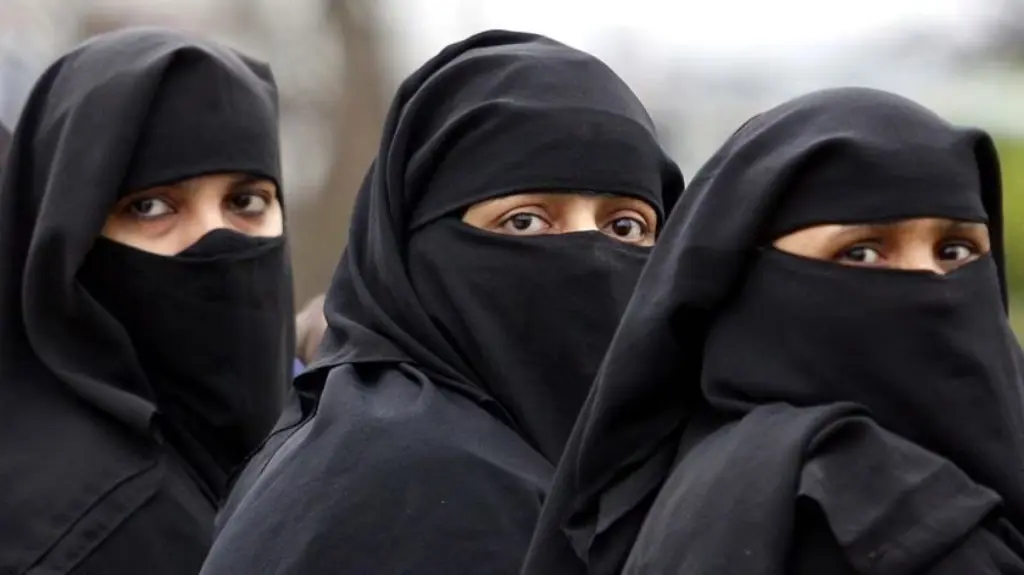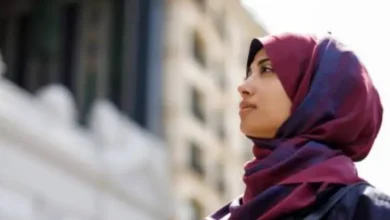The niqab, a veil that covers the face while leaving the eyes visible, is a garment deeply rooted in Islamic tradition and culture. It’s often a subject of intense debate and misunderstanding, sparking conversations about religious freedom, personal expression, and cultural identity.
This article aims to delve into the complexities surrounding the niqab, exploring its historical context, its variations, the reasons why women choose to wear it, and the controversies it generates in the modern world. By providing clear and accurate information, we hope to shed light on the nuances of this often-misunderstood practice.

Understanding the Niqab
Before diving into the debates, let’s establish what the niqab actually is. Unlike the hijab, which covers the head and neck, the niqab veils the entire face, except for the eyes. It’s typically worn in conjunction with a hijab or a similar head covering. The niqab comes in various styles and colors, though black is the most common. It’s also sometimes paired with gloves, further concealing the body. It’s crucial to differentiate between the niqab and other forms of Islamic veiling like the burqa, which covers the entire face and body, including the eyes.
Niqab vs. Other Veils:
- Hijab: Covers the head and neck, leaving the face visible.
- Niqab: Covers the face, except for the eyes.
- Burqa: Covers the entire body, including the eyes, typically with a mesh screen.
- Chador: A full-length cloak that drapes over the head and body.
Each veil carries different cultural and religious significance and is worn for different reasons.
See also Shayla: A Symbol of Identity and Tradition in Arab Culture
Shayla: A Symbol of Identity and Tradition in Arab CultureHistorical Context and Religious Interpretations
The practice of veiling predates Islam. Veiling was common in pre-Islamic societies for reasons ranging from social status to protection from the elements. With the advent of Islam, specific verses in the Quran and Hadith (prophetic traditions) address modesty.

The interpretation of these verses regarding veiling varies widely amongst Islamic scholars. Some believe that face veiling is obligatory for Muslim women, others view it as recommended, while others see it as a cultural practice with no religious basis. The niqab’s historical usage and the reasons for adopting it varied significantly depending on region and time period.
For example, some historical texts suggest that wealthy women in certain regions practiced facial veiling as a sign of status and protection from unwanted attention. It’s essential to remember that Islamic teachings are not monolithic and interpretations can vary considerably.
Varying Interpretations
- Obligatory: Some scholars believe the niqab is mandatory based on specific interpretations of the Quran and Hadith.
- Recommended: Others view it as a highly recommended practice for Muslim women.
- Cultural Practice: Some scholars and communities consider it a cultural practice not directly mandated by religious texts.
These varying interpretations have a significant impact on why women choose to wear the niqab and how their practice is perceived within Muslim communities and the wider world.
See also Assam Silk: The History of India’s ‘Liquid Gold’ in Global Luxury
Assam Silk: The History of India’s ‘Liquid Gold’ in Global LuxuryWhy Women Choose to Wear the Niqab
The reasons behind a woman’s decision to wear the niqab are varied and personal. It’s crucial to avoid broad generalizations and respect individual choices. For some, it’s a deeply personal expression of their religious devotion and their relationship with God. They believe that it allows them to practice modesty in its most complete form and acts as a barrier against unwanted male attention.
The niqab for them symbolizes piety and dedication to Islamic principles. For others, it’s a connection to their cultural heritage and a way to maintain their identity, especially if they live in a society where their religion or cultural norms are not well understood. It’s also a way to resist societal pressures and maintain a sense of autonomy.
Some might even find a sense of empowerment in choosing how they present themselves to the world, even in the context of a potentially controversial garment. Additionally, in some communities, societal expectations may play a role, making the niqab a matter of following local customs. It’s important to stress that not all women who wear the niqab are forced into it, and to deny their agency is to miss a critical part of this complex picture.
Motivations Behind Wearing the Niqab:
- Religious Devotion: A desire to express piety and obedience to religious principles.
- Personal Modesty: A way to practice modesty and seek to avoid unwanted attention.
- Cultural Heritage: A connection to cultural roots and a way to maintain identity.
- Personal Autonomy: A way to exercise agency and personal freedom in expressing oneself.
- Societal Expectations: In some communities, following local traditions and customs.
The Niqab in the Modern World: Debates and Controversies
The niqab often faces public debate, particularly in Western societies. These discussions frequently revolve around concerns about security, integration, and gender equality. Concerns are raised about the potential for the niqab to be used to conceal one’s identity for nefarious purposes, leading to calls for bans in certain public spaces, like airports or schools.
Furthermore, some see the niqab as an oppressive garment, a symbol of female subjugation that contradicts modern ideals of gender equality. This perspective argues that by hiding a woman’s face, it limits her ability to participate fully in society, especially in contexts where face-to-face communication is essential. These arguments stem from the view that women are forced to wear the niqab against their will, something that, while true in some cases, isn’t the norm across all niqab-wearing communities.
Key Points of Contention:
- Security Concerns: Fears that the niqab could be used to conceal identity, potentially posing a security risk.
- Integration Challenges: Arguments that face veiling hinders social integration and open communication.
- Gender Equality: Critiques of the niqab as a symbol of female oppression that limits their participation in society.
- Religious Freedom: Clashes between the rights of religious expression and societal norms of interaction.
Niqab Bans and Legal Challenges
Several European countries have implemented partial or full bans on face coverings in public places, including the niqab, often citing security concerns and promoting a sense of national identity. These bans have faced challenges from human rights organizations and religious groups, who argue that such laws infringe upon freedom of religion and expression.
They argue that the state should not dictate what women can and cannot wear, and that such restrictions disproportionately affect Muslim women. This is a complex legal issue with ongoing debates about balancing individual liberties and societal interests. The legal landscape is constantly evolving, with varying results in different jurisdictions, reflecting different societal views on this issue.
Examples of Niqab Bans:
- France: Introduced a ban on face coverings in public places in 2011.
- Belgium: Also implemented a nationwide ban on face coverings in public.
- Netherlands: Enacted a partial ban in specific locations like public transportation and government buildings.
- Denmark: Prohibits face coverings in public, with exceptions for certain purposes.
The Impact on Women Who Wear the Niqab

These debates and bans have a direct impact on the lives of women who wear the niqab. They can experience discrimination, prejudice, and difficulties accessing public services or employment opportunities.
The stigmatization of the niqab can lead to social isolation and feelings of marginalization. Furthermore, it has the potential to increase Islamophobia. Many feel their religious choices are being unfairly targeted and questioned. It is crucial to emphasize that these women are not a monolithic group.
They have diverse opinions, backgrounds, and reasons for choosing to wear the niqab, and their voices need to be heard in any discussion surrounding the issue. Ignoring their perspectives risks painting an incomplete and often inaccurate picture of their lived experiences.
Challenges faced by women wearing the Niqab:
- Discrimination: Facing prejudice and negative attitudes in public.
- Limited Access: Difficulties accessing services, employment, or education.
- Social Isolation: Feeling excluded or marginalized due to their attire.
- Increased Islamophobia: Being targeted by hate speech or actions due to their appearance.
Moving Forward: Fostering Understanding and Dialogue
The issue of the niqab is deeply complex, straddling the realms of religion, culture, and politics. It requires nuanced understanding and open dialogue to move beyond stereotypes and prejudice. Rather than taking a polarized stance, focusing on fostering a society that respects individual choices and religious freedom, while maintaining the principles of inclusivity and equality is essential.
This means recognizing that women who wear the niqab are diverse individuals, with varied reasons for their choice. It’s crucial to listen to their voices and create space for discussions that recognize the complexities and subtleties of the issue. Education, empathy, and genuine dialogue can help to build bridges, break down misunderstandings, and create societies that truly value diversity.
Steps Towards Fostering Understanding:
- Listen to Women’s Experiences: Create platforms for women who wear the niqab to share their perspectives.
- Challenge Stereotypes: Educate the public on the diversity within Islam and the varying interpretations of veiling.
- Promote Dialogue: Facilitate constructive conversations about the niqab within a respectful environment.
- Respect Religious Freedom: Advocate for the rights of individuals to practice their religion freely.
- Address Discrimination: Confront and address Islamophobia and discrimination against women who wear the niqab.
The niqab is more than just a piece of cloth; it is a symbol carrying profound religious, cultural, and personal significance for the women who choose to wear it. Understanding the historical context, religious interpretations, and diverse reasons why women adopt the niqab is key to having a productive conversation about it.
The debates surrounding the niqab highlight the complex interplay between individual liberties, societal norms, and cultural diversity. Moving forward, it is crucial to engage in dialogue that seeks to understand, not just judge.
Embracing a nuanced approach, grounded in empathy and respect for individual choices, is essential for building inclusive societies where all individuals can express their identities and practice their faith without fear of prejudice or discrimination. The conversation surrounding the niqab must always center around the experiences of the women who choose to wear it.




